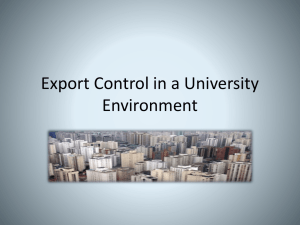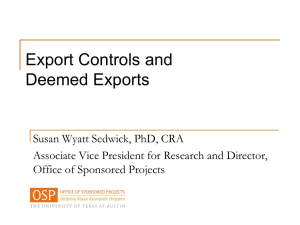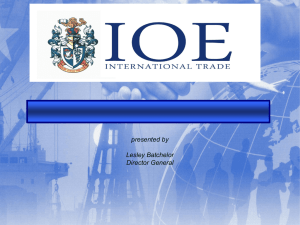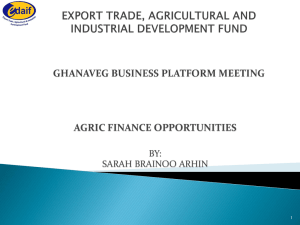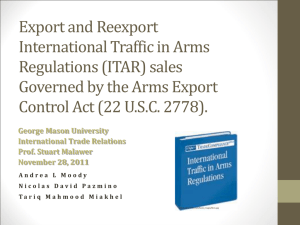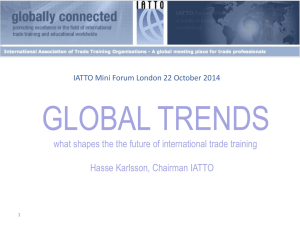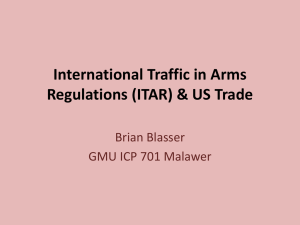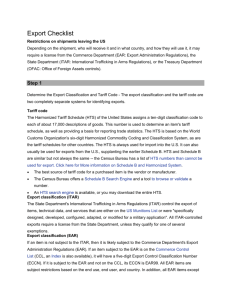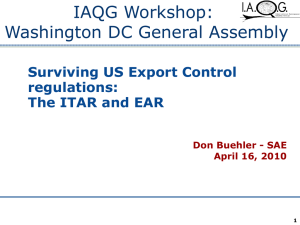Export Control at UA
advertisement
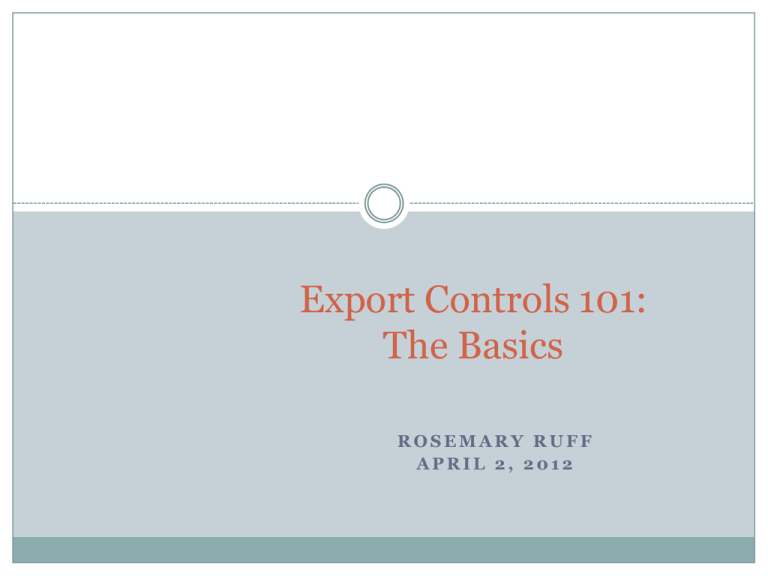
Export Controls 101: The Basics ROSEMARY RUFF APRIL 2, 2012 WHAT ARE EXPORT CONTROLS? US laws that regulate the transfer of items, technology, software, and services to foreign persons Export Administration Regulations (EAR, 15 CFR 730, U.S. Department of Commerce) International Traffic in Arms Regulations (ITAR, 22 CFR 120130, U.S. Department of State) EXCLUSIONS FROM CONTROLS Education Information concerning general scientific, mathematical or engineering principles commonly taught in colleges or universities. Applies only to information released during catalog-listed courses (through lectures, course materials, or instruction in laboratories) at – US Universities for ITAR-USML items Any University for EAR-CCL items. Fundamental Research Information arising during or resulting from basic and applied research in science and engineering at an accredited U.S. institution of higher learning where the resulting information is ordinarily published and shared broadly in the scientific community EXCLUSIONS FROM CONTROLS Public Domain Information generally accessible to the public in any form, including information: readily available at libraries open to the public or at university libraries in patents and published patent applications available at any patent office released at an open conference, meeting, seminar, trade show, or other open gathering published in periodicals, books, print, electronic, or other media available for general distribution (including websites that provide free uncontrolled access) or for distribution to a community of persons interested in the subject matter, such as those in a scientific or engineering discipline, either free or at a price that does not exceed the cost of reproduction and distribution SO WHAT’S THE BIG DEAL? Many contractual terms can affect our “fundamental research exemption” Restrictions on publications/information dissemination Ownership of intellectual property Restriction on employee participation Explicit incorporation of statutory controls WHAT’S AN EXPORT? Physical transfers of items outside the U.S. Electronic transfer (disks, RAM sticks, etc.) of software or technical data outside the U.S. Release or disclosure of software or technical data to any foreign person by e-mail, Internet, phone/fax, in-person (oral communication), or visual inspection Application of controlled data outside the U.S. ARE THERE OTHER TYPES OF EXPORT? “Deemed Export” — disclosure of technology to a foreign person in the United States. Carries same penalties and imprisonment as disclosure abroad. “Reexport” — an export of a controlled item of U.S.-origin from one foreign country to another WHAT IS A FOREIGN PERSON? A U.S. Person is a person who is a U.S. citizen, a U.S. legal permanent resident (“green card” holder) or an asylee/refugee under Federal regulation. A U.S. corporation, partnership, trust, society or other entity incorporated or organized to do business in the United States is also a U.S. Person. Everyone else is a Foreign Person. F-1, J-1, H-1B, O-1 visa holders are Foreign Persons! WHAT ARE THOSE REGULATIONS AGAIN? Export Administration Regulations (EAR, 15 CFR 730, U.S. Department of Commerce) International Traffic in Arms Regulations (ITAR, 22 CFR 120-130, U.S. Department of State) WHAT IS COVERED BY ITAR? Broad restrictions on Defense Articles and Services Technical Data Items on the U.S. Munitions List (USML) 21 Categories (including a “Miscellaneous”) all of which have strict military applications WHAT ARE SOME EXAMPLES? Launch vehicles, missiles, rockets Military aircraft and vehicles Military training and simulation Military electronics Personal Protective Gear/Equipment Toxicological agents, including chemical and biological agents, and associated equipment Spacecraft systems and satellites WHAT IS A DEFENSE ARTICLE? Any item listed on the USML Includes raw materials, components, parts, software, and related technical data Any item specifically designed, developed or modified for a military application Launch vehicles; missiles; rockets; military aircraft, vehicles, and electronics Military training and simulation Military electronics Toxicological agents, including chemical and biological agents, and associated equipment Spacecraft systems and satellites WHAT IS TECHNICAL DATA? Information required for design, development, production, manufacture, assembly, operation, repair, testing, maintenance or modification of Defense Articles WHAT IS A DEFENSE SERVICE? Furnishing of assistance or training to a Foreign Person in the design, development, engineering, production, assembly, testing, processing, manufacture, use, operation, overhaul, repair, maintenance, or modification of Defense Articles IS ITAR STRICT? Absolutely! Almost all ITAR activities require a license from the US Govt. prior to engaging in the controlled activity. Even proposal information may be controlled. WHAT IS COVERED BY EAR? Items on the Commerce Control List (CCL) including commercial as well as “dual-use” goods, software and technology Almost every other commercial item you can think of, even paper clips WHAT IS ON THE THE CCL? Ten categories: 0-Nuclear Materials, Facilities & Equipment (and Miscellaneous Items) 1-Materials, Chemicals, Microorganisms, and Toxins 2-Materials Processing 3-Electronics Design, Development and Production 4-Computers 5-Telecommunications and Information Security 6-Sensors and Lasers 7-Navigation and Avionics 8-Marine 9-Propulsion Systems, Space Vehicles and Related Equipment WHAT IS AN ECCN? Export Control Classification Number Export Control Categories 0 = Nuclear materials, facilities and equipment (and miscellaneous items) 1 = Materials, Chemicals, Microorganisms and Toxins 2 = Materials Processing 3 = Electronics 4 = Computers 5 = Telecommunications and Information Security 6 = Sensors and Lasers 7 = Navigation and Avionics 8 = Marine 9 = Propulsion Systems, Space Vehicles, and Related Equipment Five Product Groups A. Systems, Equipment and Components B. Test, Inspection and Production Equipment C. Material D. Software E. Technology Category 1, Product Group C 1C351 Human and zoonotic pathogens and ‘‘toxins WHERE DO I GET AN ECCN? Check documentation received with equipment/materials Ask the manufacturer/supplier/provider (at time of purchase if possible) Self-classify (access to instructions and EAR on RSCP export control website) Check manufacturer’s website (especially software companies) Ask RSCP to for assistance (NOTE: May require request to BIS which takes 4-6 weeks) DOES EVERYTHING HAVE AN ECCN? No. There are commercial goods not on the CCL. These do not have an ECCN. These goods are “EAR99” and do not ordinarily require a license unless the transaction involves a sanctioned country, an end-user of concern, or are intended for a prohibited end-use. ECCN = MUST HAVE LICENSE, RIGHT? Not necessarily – CCL is country dependent and there may be exceptions , e.g, Fundamental Research, Public Domain, or Educational Information Consult the Country Chart and the ECCN Check special requirements for sanctioned countries Request assistance from RSCP ARE THERE OTHER FEDERAL AGENCIES? Treasury Department – Office of Foreign Assets Control Implements and oversees economic and trade sanctions against targeted foreign countries, terrorists, international narcotics traffickers, and those engaged in activities related to the proliferation of weapons of mass destruction Certain countries and activities are “sanctioned” http://www.treas.gov/offices/enforcement/ofac/programs/ WHO BESIDES STATE & COMMERCE? Many federal agencies are charged with the control of exports other than those listed above. Examples are microorganisms, toxins, chemicals, drugs, endangered species, medical devices, gas and electric power, nuclear materials, freight shipments, vessels, etc. E.g., USDA 7 CFR 331.3 (c) – PPQ Select Agents and Toxins What About Individuals? Denied Persons List A list of individuals and entities that have been denied export privileges. Unverified List A list of parties where BIS has been unable to verify the end-user in prior transactions. Entity List A list of parties whose presence in a transaction can trigger a license requirement under the Export Administration Regulations. Specially Designated Nationals List A list compiled by the Treasury Department, Office of Foreign Assets Control (OFAC). OFAC’s regulations may prohibit a transaction if a party on this list is involved. Debarred List Parties who are barred from participating directly or indirectly in the export of defense articles or in the furnishing defense services for which a license or approval is required by the ITAR. http://www.bis.doc.gov/complianceandenforcement/liststocheck.htm UA RESPONSIBLE PARTIES Investigators Technicians/lab managers Secretarial/Clerical Students Custodians/Facilities Workers OK – now that I have your attention… violation of export controls is a personal, criminal liability. Tier 1 RESPONSIBILITIES Investigators – Assess all research activities, sponsored and unsponsored, to identify and classify controlled technology Develop export control plan Document training to all laboratory staff and students Monitor access to all research facilities/ technology/information to ensure proper control Ensure that controlled technology is not released without an export license Notify RSCP of all potential export violations within 24 hours of discovery TIER 2 RESPONSIBILITIES RSSP – review proposals and awards to assist investigators with identification and management of controlled activities RSCP – assist investigators with identification/classification controlled items/activities, apply for licenses, seek advisory opinions, provide training opportunities Office of General Counsel – review classification of controlled activities — may refer to external counsel* if unable to definitively classify an item * Investigator/Unit is responsible for all costs incurred for external opinion. Tier 3 Responsibilities Administrators cassist investigators as needed to ensure that appropriate controls are in place. Some examples: Identify immigration status of all laboratory personnel upon project inception Do not process payroll assignments without checking export control status of project Maintain security of research facilities and technology, e.g., don’t “unlock the lab door” or provide copies of proposal, reports, etc. without investigator approval Ask Purchasing to request that suppliers provide ECCNs INFORMATION AND ASSISTANCE RSCP Export Control Website http://vpred.uark.edu/211.php Basic Training Materials Technology Control Plan Forms Links to responsible Federal agencies, regulations and control lists Assistance with identification and classification of controlled technology Rosemary Ruff, RSCP– rruff@uark.edu, 575-4572 Jeff Amerine, OTL – jamerine@uark.edu, 575-2995 Mark Swaney, OTL, – mswaney@uark.edu, (479) 575-7243 Nathan McKinney, AGRI – nmckinne@uark.edu, 575-6591

